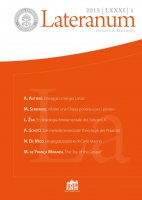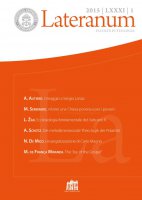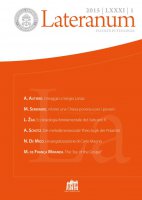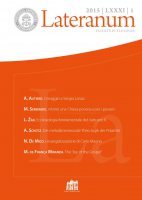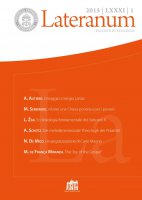Estratto
Quali stimoli possiamo ricevere dall’esortazione apostolica Evangelii Gaudium in vista di un’armonia più grande con la Chiesa Universale e per portare a compimento una migliore performance nella nostra missione apostolica? Guardando ai fondamenti dell’esortazione apostolica, che sono già presenti nell’ecclesiologia del Vaticano II e anche, in modo particolare, nel documento conclusivo della V Conferenza Episcopale Latino-Americana e dei Caraibi ad Aparecida, come possiamo comprendere l’auspicio di un “rinnovamento ecclesiale” che proviene dal testo di Papa Francesco? Non intendo qui approcciare tutte le questioni che sono presenti nel documento ma cerchiamo di illustrare, anche considerando una prospettiva storica, come Papa immagina che la Chiesa sia: una Chiesa missionaria e decentralizzata, configurata collegialmente, inculturata, formata da discepoli missionari; una Chiesa che con la vita rende testimonianza della sua fede in Gesù Cristo e, per richiamare un’espressione particolare, una Chiesa dei poveri. Poiché per le Conferenze episcopali si tratta di tradurre le linee guida dell’esortazione in contesti differenti, mi limito ad evidenziare alcuni punti e lo faccio non mediante affermazioni ma mediante domande, dando così l’opportunità per la discussione e la creatività
Parole chiave:
Papa Francesco; Evangelii Gaudium; Concilio Vaticano II; Ecclesiologia di comunione; Conferenza di Aparecida; Chiesa dei poveri
Abstract
Which stimuli can we take from the Apostolic Exhortation Evangelii Gaudium in order to be in greater harmony with the universal Church and to achieve better results in our apostolic mission? Looking at the foundations of the Apostolic Exhortation that are already present in the Second Vatican Council’s ecclesiology and also, in a special way, in the Concluding Document of the V Latin American Episcopal Conference and the Caribbean in Aparecida, how can we understand the wish for an “ecclesial renewal” that emerges from Pope Francis’ text? I do not aim here to touch on all the questions that are present in the document, but we seek to elucidate, from an historic perspective, how Pope Francis envisions the Church to be: a missionary and decentralized Church; collegially-configured; inculturated; formed by missionary disciples; a Church that bears witness in life to her faith in Jesus Christ; and, recalling a special expression, a Church of the poor. As it is the concern of episcopal conferences to implement the Exhortation guidelines within different contexts, the Author limits himself to discussing a few points, not through affirmations, but through questions, thus allowing the opportunity for discussion and creativity.
Keywords:
Pope Francis; Evangelii Gaudium; Second Vatican Council; Ecclesiology of communion; Conference of Aparecida; Church of the poor
__________________________________________________________
The vastness of the question that the National Conference of the Bishops of Brazil (CNBB – Conferência Nacional dos Bispos do Brasil) has proposed for my consideration is readily apparent. Owing both to the great importance of the themes that are present in Pope Francis’ Apostolic Exhortation, and to the several and varied pastoral activities that are developed within the Catholic Church, a further and more detailed study would be demanded, as well as a longer time for exposition. Because of those reasons, we have had to choose a specific approach in order to be able to consider the present status of the question: a subjective approach, therefore incomplete and that would possibly need to be corrected. We shall not focus on what is already a positive reality in the Church in Brazil, but instead we aim to examine the stimuli that we can take from the Apostolic Exhortation Evangelii Gaudium2 in order to be in greater harmony with the universal Church and to achieve better performance in our apostolic mission. To attain this, we shall take a look at how the fundamentals of the Apostolic Exhortation were already present within the ecclesiology of the Second Vatican Council, and also, in a special way, in the Aparecida Document. Of course it is for the CNBB to implement Pope Francis’ guidelines in our context. At this point, therefore, I will limit myself to making brief remarks by means of some questions.
We begin with some historical considerations so that we can better understand where the current Pontiff’s initiative concerning “ecclesial renewal” comes from. We cannot understand the present out of the light of the past.
Knowing about institutional transformations that happened in the past makes us more receptive to the changes that present times ask of us. In a second moment, we will look at some of the themes from Pope Francis’ text that seem striking to us. I recognize in advance that some subjects will certainly be missing and that others, for sure, deserve a more detailed exposition.
1. What history teaches us
Understanding history is something essential for the society and the Church in which we live. Successes and mistakes in the past still resonate strongly in our day. The Church is a human and divine reality. As divine, she exists through God’s initiative and has characteristics that define her theological identity: faith in the person of Jesus Christ, the proclamation of the Word of God, the mission on behalf of the Kingdom of God, the celebration of the sacraments, especially of Baptism and Eucharist, the ordained ministry, and the community of the faithful. But the Church is also a human community, embodied in history, since her members live in concrete socio-cultural-existential contexts. Only as they are children of the society in which they live, as they share a language, social institutions and behavioral patterns that enable human coexistence, can they profess and give witness to their Christian faith as an ecclesial community. Only by shaping her theological identity in her actual context, can the Church be held and understood as Church and, thus, fulfill her mission to proclaim the salvation of Jesus Christ to the world. Otherwise she will be seen as an archaic reality, a museum piece, and not as a significant or relevant reality for our contemporaries.
History shows us that societies, mentalities, social institutions, languages, and behavioral patterns change through the time. The Church should be able to be understood and experienced by society as a sign and sacrament of the salvation of Jesus Christ to the world. Otherwise, she will be seen as a reality that belongs to the past, one that has nothing to say about the present life. Hence, she should change her institutional settings to keep her identity of salvific mediation, which is, after all, the meaning of her existence.
From this perspective we can understand the historical changes that took place in the liturgy, in certain doctrinal expressions, in the organization of the community, in pastoral guidelines and in the service of charity. Also from this perspective, we can assume that the Church lives in a constant historical process of institutionalizing herself. If we have difficulties accepting changes, this is due to a particular institutional configuration that conditions our understanding of the Church, which in turn prevents us from thinking about the Church in a different way. A season of changes is at the same time a season of resistance to changes.
[...]





